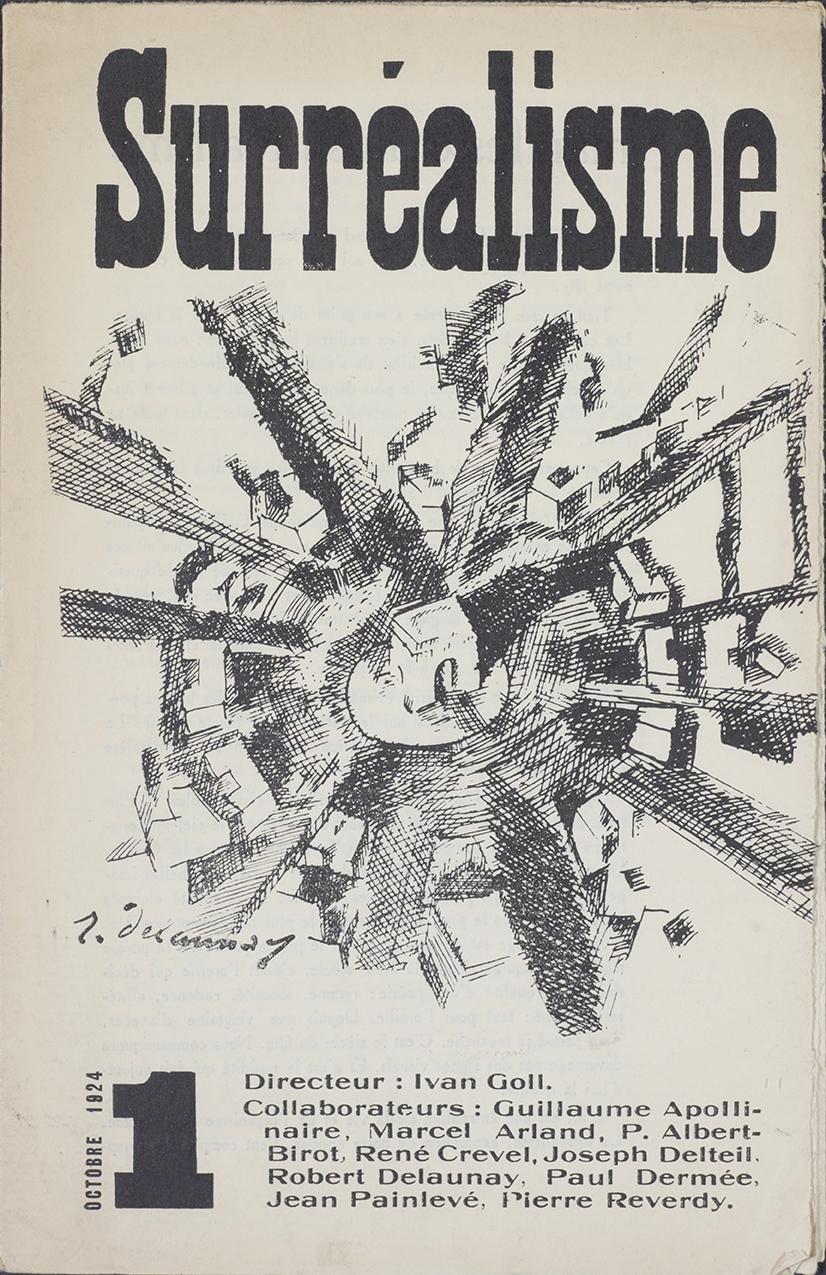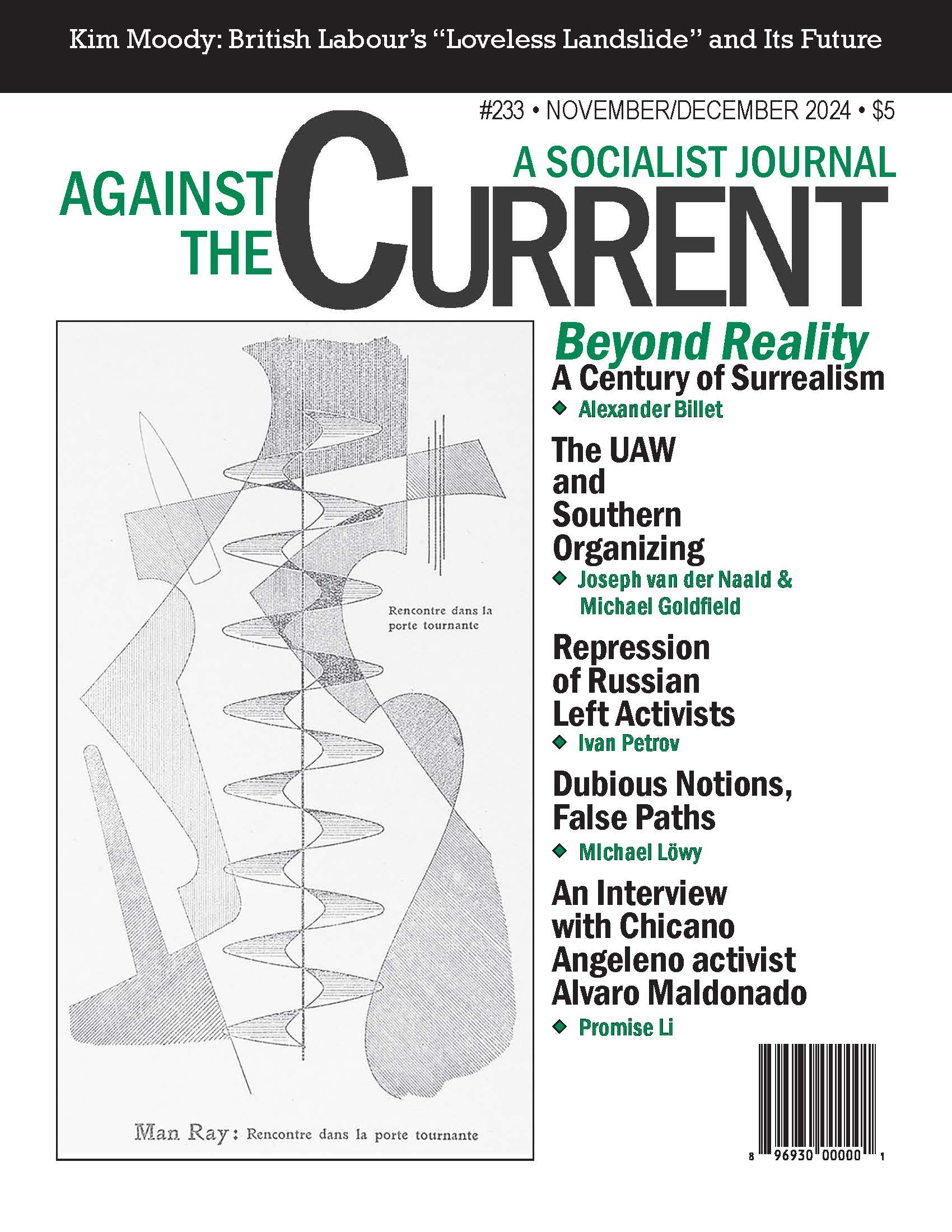Against the Current No. 233, November/December 2024
-
Election and Widening War
— The Editors -
Beyond Reality: On a Century of Surrealism
— Alexander Billet -
Harris, Trump, or Neither? Arab & Muslim Voters’ Anger Grows
— Malik Miah -
Discussing the Climate Crisis: Dubious Notions & False Paths
— Michael Löwy -
Repression of Russian Left Activists
— Ivan Petrov -
Political Zombies: Devouring the Chinese People
— Lok Mui Lok -
Nicaragua Today: "Purgers, Corruption, & Servility to Putin"
— Dora María Téllez -
Labour's "Loveless Landslide": The 2024 British Elections
— Kim Moody -
Chicano, Angeleno and Trotskyist -- A Lifetime of Militancy
— Alvaro Maldonado interviewed by Promise Li -
Joe Sacco: Comics for Palestine
— Hank Kennedy - Essay on Labor Organizing
-
The UAW and Southern Organizing: An Historical Perspective
— Joseph van der Naald & Michael Goldfield - Reviews
-
On the Boundary of Genocide: A Film and Its Controversies
— Frann Michel -
Queering China in a Chinese World
— Peter Drucker -
Abolition, Ethnic Cleansing, or Both? Antinomies of the U.S. Founders
— Joel Wendland-Liu -
Emancipation from Racism
— Giselle Gerolami -
The Labor of Health Care
— Ted McTaggart -
In Pristine or Troubled Waters?
— Steve Wattenmaker - In Memoriam
-
Ellen Spence Poteet, 1960-2024
— Alan Wald
Alexander Billet

FEW WORDS IN today’s vernacular are as exhausted as “surreal.” Used to describe everything from celebrity sightings to deodorant commercials, it occupies a similar space as “Kafkaesque” and “Orwellian” — a literary or aesthetic posture mentioned so frequently that its meaning dulls.
You’d be forgiven for thinking that the surreal is simply strange, that it’s just another imprecise descriptor drifting through the thin gruel of whatever comes after postmodernism. That seems to be the thrust of many commemorations of surrealism’s 100th birthday, designed as they are to be bought and giggled over in a museum gift shop. Strangeness is certainly part of surrealism, though to leave it at that would be woefully insufficient.
The first order of business, then, is to reestablish surrealism’s original meaning. Surréalisme, a word coined by Guillaume Apollinaire in 1917: sur, meaning “beyond,” and réalisme, “realism.”
To go beyond reality. How can we not crave this? We are bombarded on a daily basis by headlines that declare us expendable and unworthy. Endless wars, jobs that sort us into ever more isolation while paying us less, governments that revel in their indifference and cruelty. In this context, orchestrated moments of the quirky or unexpected become a safety valve, a window of difference metabolized into the repressive same.
This is not what the writers and artists who called themselves surrealists had in mind for their movement. Theirs was not a rebellion for the sake of rebellion, still less for the sake of conformity.
They had seen first-hand the carnage of World War I, the use of industrial technology to kill thousands in an instant, rendering whole swathes of Europe into pits of mud and barbed wire and dead bodies. They watched as Italy fell to fascism, while France and Germany sunk into a complacent decadence buoyed by crushing poverty.
A perverse bourgeois calculus of prosperity and suffering had prevailed. The rationalization of life had made it cheap and easily disposed of. To the surrealists, this culture sought not to inspire but to sort and arrange the human condition into a gray, predictable pattern.
Writing of what he termed this “realistic attitude” in 1924’s Manifesto of Surrealism, Andre Breton wrote “I loathe it, for it is made up of mediocrity, hate, and dull conceit. It is this attitude which today gives birth to these ridiculous books, these insulting plays. It constantly feeds on and derives strength from the newspapers and stultifies both science and art by assiduously flattering the lowest of tastes; clarity bordering on stupidity, a dog’s life.”
“A gothic Marxism”
Second order of business: reclaim surrealism as a revolutionary project. It wasn’t merely that Breton, Pierre Naville, Luis Buñuel, Benjamin Peret and other poets and artists who founded the movement also happened to consider themselves Marxists and communists. Theirs was, in the words of Margaret Cohen in her book Profane Illumination, “a gothic Marxism.”
Michael Löwy elaborates, describing this as “a Marxist genealogy that is fascinated with the irrational aspects of the social process; as a genealogy that tries to study how the irrational penetrates existing society, and dreams of using the irrational to bring about social change.”
Provocative? Yes. But potent. The psyche fractured by postwar capital contained countless overshadowed dimensions, repressed impulses that threw into question the prevailing order’s seeming impregnability. Influenced by Freudian psychoanalysis, the surrealists saw something radical and liberatory in these diverted desires, and sought to unearth them.
The aesthetic practices of the surrealists, therefore — the automatic writing, the experiments with hypnosis, Breton’s “pure psychic automatism” — were not simply aesthetic practices. To place an umbrella and a sewing machine on a dissecting table — paraphrasing the Comte de Lautreamont — was not just a collection of items that “shouldn’t” go together. It was a challenge to the reader to divine meaning from this seemingly mundane yet nonsensical pairing.
What might this meaning be? And what might emerge from these revealed gaps between what is and what could be?
Surefire blueprints weren’t in the surrealists’ wheelhouse, but they did look to the hidden corners of existence, the traces and phantoms of chance, the places and practices of the conquered and exploited, to help them understand.
Third order: dispel the myth that surrealism was only a white, European movement. This would surely be news to the likes of Aimé and Suzanne Césaire, or Diego Rivera and Frida Kahlo, all of whom either counted themselves part of the surrealist movement or were politically and artistically close to them.
Disagreement over whether Rivera might be counted a surrealist is valid — though his ability to tease out the utopian from the absurd and thrilling collision of history cannot be denied.
Kahlo’s paintings — fantastic, revelatory, slipping between dream and reality — require far less qualification. That both were communists is well known, and their valorization of colonized indigenous and Latin American peoples was central to their communism.
The Césaires deserve as much recognition. By the time their European counterparts had made contact with them in Martinique during World War II, Suzanne and Aimé had already been publishing their own surrealist publication, the militantly anticolonial Tropiques. The years after the war saw Aimé elected a member of French parliament as a Communist, and he would continue to publish some of the most unique poetry, theatre, and essays in the surrealist canon.
As for Suzanne, his wife, she was as great a talent, overshadowed not just thanks to patriarchy but her death at the relatively young age of 50 in 1966. “Surrealism lives!” she would declare in a 1943 essay, in which she credits the movement with giving voice to lives “everywhere — in New York, Brazil, Mexico, Argentina, Cuba, Canada, and Algiers — other voices also resound: voices that would not be what they are (either in timbre or resonance) without surrealism.”
Fourth order: make clear that, however much surrealism reflected the early 20th century’s retrograde ideas of gender and sexuality, its dialectic points toward the subversion of these same mores.
Cohen euphemistically calls out Breton’s “assertive heterosexuality.” More straightforward descriptions might just be sexism and homophobia, which led him to exclude and expel many queer and women surrealists.
This, however, didn’t stop queer and women surrealists from existing, or from using the movement’s aesthetic strategies to explode the strictures of sexuality. Consider, for example, Claude Cahun. Born Lucy Renee Mathilde Schwob, she dressed in men’s clothes and explored the permeable borders of gender roles in her photomontages. “Masculine? Feminine? It depends on the situation,” she wrote in her autobiography. “Neuter is the only gender that always suits me.”
During World War II, Cahun founded the anti-fascist group Contre Attaque, whose members found creative and original ways to undermine occupying Nazi troops. She was arrested in 1944 and sentenced to death. She was spared by the end of the war, but her time in prison permanently damaged her health.
Though some feminists have criticized the use of sexualized imagery in surrealist art, women surrealists have argued that, at their best, these images sought to question rather than reinforce. “If I cut off the credits from my films,” said Argentinian filmmaker Nelly Kaplan, “people wouldn’t be able to tell if they were made by a man or a woman.” The history of surrealist feminism is rich.
[See Surrealist Women: An International Anthology, edited by Penelope Rosemont (University of Texas Press) —ed.]
The Ordinary Is Surreal
Fifth and final order: to assert that the surreal is ordinary, and the ordinary is surreal. Intrinsic in the contradictions that make life a grating hell are also the possibilities of transcendence, though what that transcendence looks like isn’t always so clear.
One might be surprised by the works counted by their makers as surrealist. This includes one of the great American novels of the 20th century, so often misunderstood as a work of straightforward realism: Richard Wright’s Native Son. As Robin D.G. Kelley writes in Freedom Dreams, Wright saw much of his work as sitting comfortably in the radical oeuvre of surrealism.
“Wright did not try to pass off Native Son as social realism or proletarian realism,” writes Kelley. “Rather, it is a psychological journey that attempts to communicate what’s incommunicable; it is about alienation and yearning for something, but Wright isn’t sure exactly what it is.”
For sure, the brutal actions of Wright’s protagonist Bigger Thomas spring from a lifetime of racism, degradation, and dehumanization. What Wright forces us to ask, however, is why such inhuman treatment produces more of the same, and what becomes of the human that, despite everything, continues to exist. And why the urge to escape — not just prison but circumstance itself — is such a strong one.
The alienation, the quotidian violence and celebrated cruelties, these surround us even more than they perhaps did in the time of Wright, of Breton, of Cesaire. They are no longer so strange, but remain eldritch and uncanny, as if we’re watching film of a fictionalized life we are also forced to live.
Breton once provocatively wrote that “The simplest Surrealist act consists of dashing down the street, pistol in hand, and firing blindly, as fast as you can pull the trigger, into the crowd.” That’s no longer so rare an occurrence. It happens regularly in American schools and public spaces.
This essay is written at a time when the surreal is being employed in a worrisome manner. U.S. Democratic presidential candidate Kamala Harris and her running mate Tim Walz have decided their best line of attack against Donald Trump and the Republicans is to repeatedly and fervently call them “weird.”
Leaving aside the question of efficacy, one has to wonder whether there are long-term ramifications for the American imagination. To hear the American liberal speak, all one has to do to stop the rise of authoritarianism is cling fiercely to a sane and civilized reality. Never mind that that reality is what brought us to this brink in the first place.
For every vision of a different and better order — be it the end of segregation or the idea of a world without war — at first seems “weird” too. The impulse toward freedom and hope, buried as it is under all sorts of useless, alienating work and garbage ideology, appears foreign. Our senses aren’t sure how to understand it at first. Which doesn’t make it any less human. The need to go beyond, to escape, to discover a life of collective meaning, persists.
November-December 2024—ATC 233

